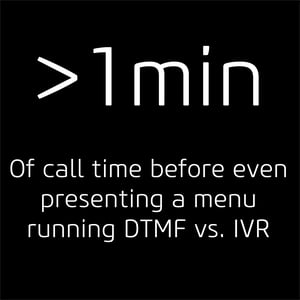Conversational IVR
Interactive Customer Response
We all have heard the stories and maybe you have even lived it, speech is going to change the IVR customer experience. With speech, your customers will find it easier to navigate the front-end system to either serve themselves or get to the person with the right skills to fulfill their service request or question quicker. Sound familiar?
Chances are that if you tried this in your business you likely experienced a very difficult project, that cost a lot of money and you may have pulled the plug on the solution due to customer complaints and poor KPI’s. The truth is that the tools had limitations and people did not know how to interact with the speech interface.
Or perhaps you heard the stories of failed implementations and opted to stay with your legacy touch-tone IVR.These traditional solutions are prevalent today, with menus designed by the business to hopefully route callers to the right place. However, in most cases, customers eventually find an agent that will help them with their inquiry.
But is it enough?
While not skeptical by nature, I am curious. I also believe in letting data drive decisions vs. theories and ideas. So, I conducted a little market test to see how many companies today were still using traditional DTMF-based IVR systems, and how many had successfully integrated Directed Speech. I assembled a list of 20 large B2C organizations and made some phone calls. Here is what I learned:
 Observation # 1:
Observation # 1:
Traditional IVR is still the defacto implementation.
Of the 20 companies I called, 18 of them were running a DTMF-based IVR. Two of them used speech-based solutions (Interestingly, both were using a structured design such as ‘Press or Say’, or Directed Speech such as for service in English, say ‘English.)
 Observation #2
Observation #2
You only get a moment to make a good impression.
In the 18 DTMF-based IVRs, by the time I…listened to the greeting, selected the language, heard the general announcements, and was pointed to their website for additional information. I was on the phone for well over a minute, and this was before I had the chance to select an option from the main menu.
20 seconds.....30 seconds.....40 seconds....50 seconds.......60 seconds........

While toll isn’t expensive, that is one minute per caller that is adding very little value for the customer. It's difficult to measure attempts at redirecting calls to the website, and instead of making a great impression in the first minute of the call, it merely provides a common experience and uses up precious time.
A personal note: One of my favourite common messages is ‘Listen carefully as our menu options have changed’. Every time I hear that I can’t help but wonder how many callers know the menu system so well that they have memorized the menu selections? And if some do call that often, perhaps it speaks to a different challenge altogether?
 Observation #3 – We are masters at complicating this process.
Observation #3 – We are masters at complicating this process.
Of the 20 accounts I investigated, all of them did a great job deferring the customer call by directing them to their website and by hiding the customer service telephone number deep in their contact info.
Practically, when a customer does call, self-service options are limited and if they do want to speak with an agent, they often experience long
wait times creating a frustrating experience for the customer, and a difficult conversation for the agent.

We can do better.
Does any of this sound familiar to you? If so, you are not alone.
Bob Dylan is often quoted as saying "the times they are a-changing" and I believe that is true in the world of customer experience and IVR today.
Natural Language Processors (NLP’s) have evolved from being expensive proprietary solutions to free, commonly used platforms such as Siri, Alexa and Google. While not perfect, these solutions are getting better, smarter, and more accurate by the day because can talk to them like you would a person.

When coupled with proprietary solutions that support authentication through voice biometrics, such as sediment analysis through speech analytics, to determine if there is a frustration or anger in the customers voice; these options offer more opportunities to provide a better customer experience – which has been the goal all along.
You can take these solutions even further by building in business logic that can help your customers navigate any communication channel of their choice. This makes the promise of “Build it once and apply it across all channels” a reality and it’s drastically changing the game.
Conclusion
This analysis of the midmarket space across several verticals determined that many companies have not yet implemented speech to their IVR’s and none of the companies had implemented a Conversational AI front-end.
As we continue to see rapid growth in the world of AI, we can conclude that some companies are still in the learning process of what IVR intelligence can do, plus the benefits of having a system that enables learning that’s designed by the customer.
Important factors to remember when making the investment towards the migration of your legacy IVR, is the impact of providing a system that enables learning designed by the customer- influencing measurable ROI, significant increases in KPI’s such as FCR, and improving your organization's NPS scores.
Learn how DTMF IVR’s voice channel interface can adversely impact your organization.






Submit a Comment